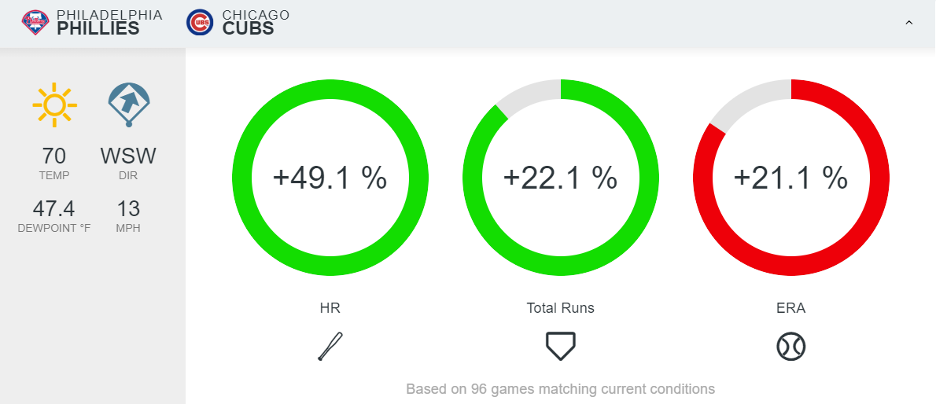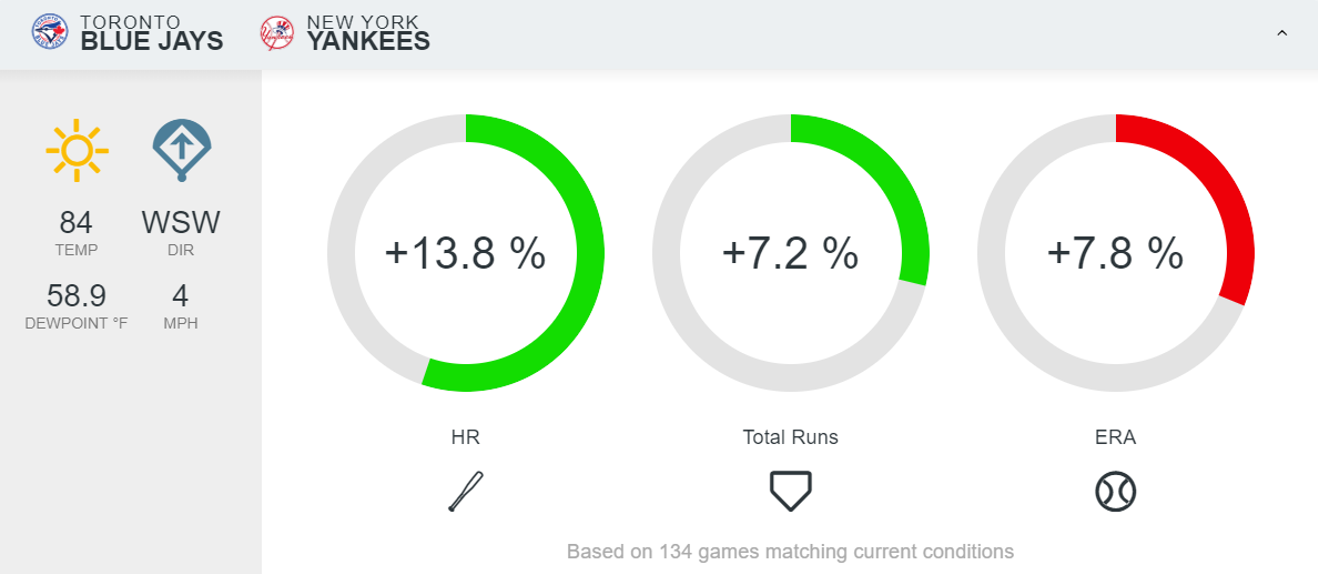MLB DFS Weather Primer
Everyone knows that rain is a huge part of daily fantasy baseball. I was hired at RotoGrinders specifically to help people avoid those rainout zeros that can wreck MLB lineups, but the more I looked at weather, the more I became interested in the weather that no one was talking about — the little MLB weather variables that can make a big difference.
I’ll start with the most obvious, and we’ll work our way into the more interesting stuff.
Wind Strength/Orientation
This one doesn’t take a degree in meteorology to figure out. If winds are blowing out from home plate to the outfield, that wind will literally help carry the ball over the fence on a deep fly. If winds are blowing in, it has the opposite effect. Certain parks are very wind sensitive, and the results can be extreme. In Wrigley Field, a wind blowing out at 10 mph or greater increases home runs by aprox 50%, while a wind blowing in at >10 mph decreases HRs by 33%. That is a massive swing in outcomes based purely on wind orientation.

To keep things nice and easy, RotoGrinders has an automated forecast tool that shows wind strength/direction overlayed on to each specific stadium on our MLB weather page.
To make matters more interesting, each stadium responds to wind a bit differently. Let’s use the 10 mph example from Wrigley and apply it to Oracle Stadium in San Francisco. Here the result of a 10+ mph wind blowing out represents only a 6% increase in HRs. This ballpark was specifically built to minimize wind impacts from this direction, so the results make sense. Each park has its own micro-climate, and we paired with WeatherBell (a weather data company) to see how each park is impacted by different weather conditions. Get the MLB WeatherEdge tool to check it out for yourself.
Elevation
The higher up you are, the thinner the air gets, and thus the farther a ball travels. Thinner air at elevation can also impact pitches themselves; if there’s less air resistance on the ball, it’s harder to get a breaking ball to break. There’s a reason Coors Field is at or near the top of ballparks for scoring every year.

Temperature
The best way to explain this is to simply say that hot air is thin air, and cold air is dense air. The warmer it is, the better it is for hitters, as the ball carries farther in hot thin air. In the following examples at Yankee Stadium, wind is not a significant factor in either data set (only 4mph in the first game, and blowing across the field in the second game), but the hitting conditions are still very different. The first game was played in warm weather, and expected HR’s jumped 14%. The second game was played in weather that was 35 degrees cooler, and the expected HR% dropped 30%.


Humidity
There’s a reason this is fourth on the list, it’s not as big of a factor as the others, but it still matters. Counter-intuitive as it is, humid air is actually less dense than dry air. We already know that less-dense air helps a well-hit ball travel farther, so that means that a hot humid day has some of the best hitting conditions out there (see: Arlington). I prefer to use dewpoint as a measure of humidity, and would consider dewpoints around 50 or lower to be dry, with dewpoints over 70 to be very humid. Again we can look at these parameters on the RotoGrinders MLB Weather page or my new WeatherEdge tool. Below is a heat/humidity combo game in Saint Louis, another game where wind isn’t a significant factor at just 4mph, but the high heat and humidity increased HR% by 20%.

I think that’s a pretty fair rundown of how and why weather matters to MLB DFS scoring. Thanks for giving it a read. If anyone has questions I’m always willing to chat, so hit me up on Twitter, @KevinRothWx.
- Kevin Roth – Chief Meteorologist at RotoGrinders.com